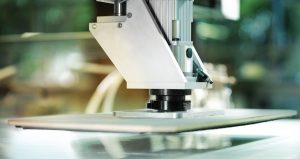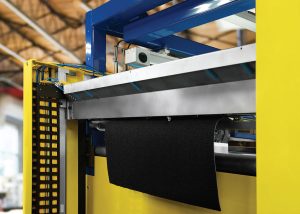
SoftWear Automation hopes to disrupt the traditional sewing model and bring apparel manufacturing back to the United States — creating jobs in the process.
TW Special Report
Within the textile supply chain, fabrics are cut and turned into finished products during what is known as the sewn products stage. During this stage, materials are transformed into various products such as high-fashion apparel, home goods, military dress uniforms, life-saving medical supplies and airbags, and more.
As technology has evolved, the steps in this cut-and-sew process have become increasingly automated. Designers now use computer-aided design software to visualize new products that are then cut by computer-controlled technologies capable of making precision cuts to fabrics ranging from lightweight silks, to heavy denims, to technical air-bag fabrics.
Still, the one stage in the production chain that has continued to evade automation is is the labor intensive and costly process of sewing. Consequently, in order to “chase the cheapest needle,” sewn goods manufacturers have relocated operations to countries paying the lowest wages to reduce their overhead.
However, Atlanta-based SoftWear Automation Inc. hopes its fully autonomous SEWBOT® can disrupt the traditional sewing model and revolutionize the $100-billion sewing industry. Formally established in 2012, the machine vision and robotics startup launched out of the Georgia Institute of Technology after seven years of research and development with the Defense Advanced Research Projects Agency (DARPA) and the Walmart Foundation. From the beginning, Sewbots were developed as an advanced, automated sewing technology that could help regrow the cut-and-sew industry in the United States.

All Sewbots feature revolutionary Threadvision and Qualisight machine vision technology that tracks stitching at the needle level and helps coordinate precise movement of the fabric. SoftWear Automation has engineered a family of Sewbots, each with a distinct set of skills and capabilities to address fabric handling and construction. Sewn goods worklines are constructed using a Sewbot or combination of Sewbots to create optimal single-piece workflows for various product types.
The LOWRY SEWBOT®, for example, is based on a gantry system, and is well-suited for home goods such as bath mats, towels, area rugs, pillow covers and mattress covers as well as some medical and automotive products, and flags and banners.
“When you eliminate the sewing problem, and automate that facet of the production chain with our Sewbots, your equation of what’s possible in regard to manufacturing and scale is endless,” said Palaniswamy “Raj” Rajan, chairman and CEO, SoftWear Automation. “Everything else in the fabric construction chain is automated. Fabric construction is automated, yarn making is automated, cutting is automated … Automating the sewing process unlocks enormous potential.”

Amazing Advances In Productivity
The advances in productivity the Sewbots represent are nothing short of amazing. SoftWear Automation reports that for most sewing processes, its Lowry Sewbot can increase output by 150 percent. For example, it takes the Lowry Sewbot just 20 seconds to serge the outer edges of a bath mat, a process that takes a human operator 30 seconds to complete. Over an eight-hour shift, the Lowry Sewbot can serge 1,440 mats, compared to a human operator’s 960. Furthermore, SoftWear Automation reports that one operator can supervise up to six Lowry Sewbots at a time.
In the case of microfiber towels, the Lowry Sewbot reduces the time it takes to serge the outer edge of cut pieces to 45 seconds, a 285-percent reduction compared to the 129 seconds that it normally takes a human operator to perform the same task.
In addition to greater productivity, the Sewbots also offer increased quality. The Sewbot’s complex machine vision systems can place a needle with extreme precision, ensuring consistency and quality in every product.
“Once you deploy the Sewbot, there is no training,” Rajan said. “There is no ramp up with sewing operators getting up to speed. Quality, reproducibility — it’s all consistent. Today, in the same factory from operator to operator over different shifts, you get stitch length and stitch density variation. But you have a higher value, more consistent product with a Sewbot. Those are the benefits of moving to Sewbot production — reliability, consistency, efficiency.”
New worklines are also on the horizon, such as a digital T-shirt workline that SoftWear Automation plans to release soon. According to the company, one T-shirt workline with one operator can sew all 13 steps required to complete a collared shirt in 162 seconds compared to 10 operators on a sewing line, who take 350 seconds to complete the same tasks. That increase in productivity equates to 1,142 shirts sewn using the automation technology in an eight-hour shift versus 669 shirts sewed by humans.
“The big reveal will change everyone’s perception of what’s coming,” Rajan said. “If you look at T-shirts, there are some astounding statistics — U.S. consumers buy 3.5 billion T-shirts each year and 98-percent of them are imported. Theoretically, based on our technology and calculations, with less than 15,000 Sewbots, we can produce the world’s T-shirts. If you want to produce a billion T-shirts in this country, we can integrate here and keep $5 billion in the economy, which creates jobs — farming jobs, jobs in the textile sector, retail jobs, and distribution jobs.
“SoftWear Automation has set a public goal to have the capacity to make 100 million T-shirts within the next five years in the United States,” Rajan continued. “Within the next 10 years, we’ll have capacity for 1 billion T-shirts here in the United States.”
Solving Problems: On-Demand, Made-To-Measure
SoftWear Automation envisions an industry that makes clothing based on demand and made-to-measure. “Our plans are to go beyond T-shirts to dress shirts, to shorts, into jeans — essentially high-volume basics. If you are buying high-volume apparel, we want to try and manufacture most of that in the United States because we want to bring mass personalization with our on demand, made-to-measure initiative.”
On-demand manufacturing reduces the need for warehouses to maintain high levels of inventory for products that a consumer may, or may not, want. Made-to-measure business models address issues with standardized sizing by allowing consumers to purchase clothing that fits and works with their body type. Solving fit issues also helps to reduce the likelihood of apparel item returns and increases profitability for retailers.
“There are many advantages for moving to an on-demand, made-to-measure business model,” Rajan said. “But it can only be accomplished if you are local. As a U.S. company, you cannot do on-demand manufacturing if you are not making products in the United States.” SoftWear Automation’s SEWLOCAL™ concept combines on demand and made-to- measure ideas with a local production location. “Our technology offers high-speed industrial manufacturing that can be located in the middle of cities, close to the consumer” Rajan said. “Or, manufacturing could be very close to a distribution hub so products can be made and shipped to a customer within 48 hours.”
The company also sees tremendous advantages of moving to hyper-local manufacturing when it makes sense. For example, championship team shirts, which must be made immediately available following the completion of a championship game, are printed for both participating teams prior to the event. Following the game, the winning team’s shirts are sent to retail, while the losing team’s shirts are destroyed. “But if you are located close to the population as a manufacturer, you can start production as soon as you get the results and have the shirts delivered on the same day,” Rajan said.

U.S.-Focused Business Model
For SoftWear Automation, production is optimized when the distances from raw material to factory to consumer are minimized. The United States offers tremendous opportunities in that respect.
“The United States is the third largest producer of cotton, so you can make your shirt using local resources,” Rajan said. “The United States also has a thriving man-made fiber and yarn industry, so finished goods do not have to be limited to cotton products. For SoftWear Automation to focus on the U.S. market and bring cut-and-sew manufacturing back to the textile sector is just a no brainer. When you look at our vision of on demand, made-to-measure using a local supply chain, this is ground zero as a country.”
Future Outlook: Robots Need Humans
The mental image of robots joining the existing automation technologies used in the sewn products industry may suggest significant job losses as human employees are replaced by robots. But this stark vision could not be further from the truth. Automated production will create new jobs, especially in high-cost labor markets, as segments of the industry return to the United States, according to SoftWear Automation. People are needed to program and maintain the machines, and often workers take an interest in learning about new technologies so they can progress from lower-wage, less-skilled jobs into high-paying positions.
According to the report, “Humans Wanted: Robots Need You,” published by Milwaukee-based ManpowerGroup “… more employers than ever — 87 percent — plan to increase or maintain headcount as a result of automation for the third consecutive year.” The company surveyed 19,000 employers in 44 countries to gain a clearer picture on the impact of automation on job growth. The survey found that companies investing in digital technologies and shifting tasks to robots are the companies creating the most jobs.
“The focus on robots eliminating jobs is distracting us from the real issue,” said Jonas Prising, ManpowerGroup chairman and CEO. “More and more robots are being added to the workforce, but humans are too. Tech is here to stay and it’s our responsibility as leaders to become chief learning officers and work out how we integrate humans with machines. Learning today cannot be done as it was in the past.”
“SoftWear Automation is here to transform this industry,” Rajan stated. “And we are giving the industry practically no reasons not to join us on this journey.”
Editor’s Note: This article appears in Textile World courtesy of the National Council of Textile Organizations (NCTO) as part of the “American Textiles: We Make Amazing™” campaign. NCTO is a trade association representing U.S. textile manufacturing. Please visit ncto.org to learn more about NCTO, the industry and the campaign.
July/August 2019




